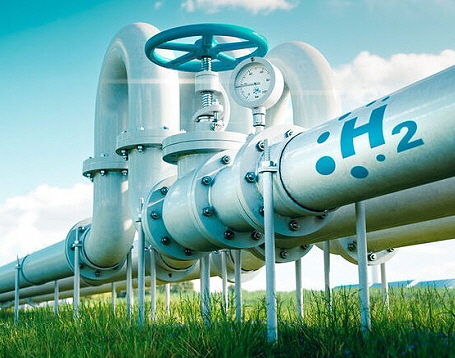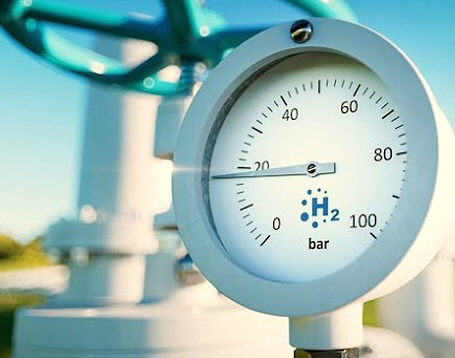

Index Home Desert-Electricity World Deserts Electric Network Types of Produktion Comparison Water Network Hydrogen New Industry Green Cities Energy Transition Imprint
Hydrogen
Due to its properties, hydrogen is expected to be the fuel of the future. Hydrogen burns without leaving any residue and does not release any pollutants. Only pure water is produced during combustion. If you burn 1kg of hydrogen, you get 39.6 kilowatt hours of energy.
However, the amount of electricity required for this one kilogram is between 40 – 80 kWh/kg, depending on the electrolyser. This roughly corresponds to an efficiency of 80 – 40%. We have to invest a little more energy than we will get back later.
In order for this process to be truly pollutant-free, the electricity used to produce the hydrogen must also be produced pollutant-free. In order to achieve the highest possible efficiency, ideally around 80%, this hydrogen should neither be stored nor transported. It is best to produce the hydrogen directly where it will then be used.



Adapted hydrogen stations, in the immediate vicinity of consumers, small low-pressure. networks for producers, villages, urban settlements that are close to each other, represent the most sensible type of use. Short supply routes are the guarantee for a truly loss-free and green use of hydrogen.
We need the international energy and water network for exactly this purpose!
Because it makes sense to produce hydrogen intended for green heat generation locally preferably. However, we need a) a lot of water, which of course cannot come from groundwater resources and b) a lot of electrical energy, which we cannot provide with wind turbines and photovoltaics. In any case, both of the above-mentioned types of production have so many disadvantages that we should not push the further expansion of these forms of production, rather even reverse their development.
It makes no sense to transport hydrogen cooled in tankers over thousands of miles, convert it at port terminals and then transport it in pipelines from the coast inland to the industries. Because if we do this, we will forfeited the absence of pollutants and the efficiency. It also makes no sense to use hydrogen to generate electrical energy in power plants. The efficiency would only be 20-40% and the ships' emissions of CO2 and pollutants would be so high that it would be better to continue burning natural gas to generate electrical energy.
Das Problem bei Wasserstoff ist, dass ein sehr hoher Druck, in gasf├Ârmiger Form von 200 – 700 bar oder in fl├╝ssiger Form eine extrem niedrige Temperatur von -253 ┬░C, notwendig ist, damit m├Âglichst viel Gas auf einem ├╝berschaubaren Raum gespeichert werden kann. Wasserstoff hat im Vergleich zu vielen Kohlenwasserstoffen eine niedrige molare Verbrennungsenthalpie und damit eine niedrige volumenbezogene Energiedichte, ca. 1/3 von Erdgas und so w├╝rden auch die Tanks entsprechend 3 mal gr├Â├čer ausfallen. Bei einem Flugzeug w├Ąre der Tank mit fl├╝ssigem Wasserstoff um den Faktor 3,4 gr├Â├čer als der mit Kerosin, weshalb ein Interkontinentalflug via Wasserstoffturbinen in heutigen Gro├čflugzeugen so nicht machbar ist. Die ben├Âtigte Energiemenge die n├Âtig ist um den Wasserstoff zu verfl├╝ssigen und zu die Temperatur w├Ąhrend der Lagerung zu erhalten mindert den Wirkungsgrad erheblich. Wasserstoff kann mit geringerem Druck nur in unterirdische Kavernenspeichern nahezu verlustfrei f├╝r l├Ąngere Zeitr├Ąume lagern. Bei der Speicherung im Druckspeicher gehen in etwa 10 bis 15 Prozent der Energie verloren.
The problem with hydrogen is that a very high pressure, in gaseous form of 200 - 700 bar or in liquid form an extremely low temperature of -253 ┬░C, is necessary so that as much gas as possible can be stored in a manageable space. Compared to many hydrocarbons, hydrogen has a low molar enthalpy of combustion and therefore a low volume-related energy density, approx. 1/3 of natural gas and so the tanks would also be correspondingly 3 x larger. In an airplane, the tank with liquid hydrogen would be 3.4 times larger than the tank with kerosene, which is why an intercontinental flight using hydrogen turbines is not feasible in today's large aircraft. The amount of energy required to liquefy the hydrogen and maintain the temperature during storage significantly reduces the efficiency. Hydrogen can be stored at lower pressure only in underground caverns for longer periods of time with almost no loss. When stored in the pressure accumulator, around 10 to 15 percent of the energy is lost.
Index Home Desert-Electricity World Deserts Electric Network Types of Produktion Comparison Water Network Hydrogen New Industry Green Cities Energy Transition Imprint